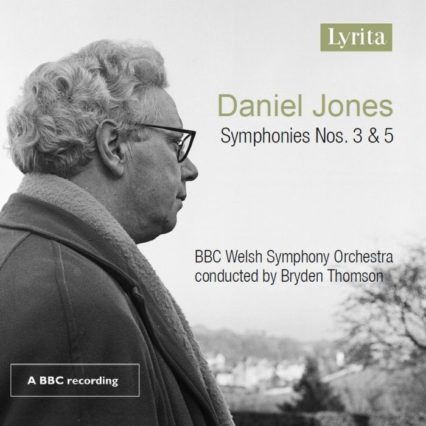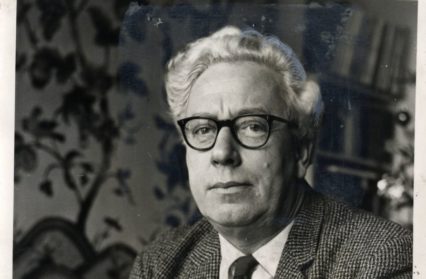Daniel Jones’ Symphonies Nos. 3 and 5 – David Truslove reviews the latest remastering of Daniel Jones’ work and finds it well served by Lyrita’s continued championing.
‘He knows what he wants, he knows what he’s writing, and he knows when it isn’t right. You can’t say that about a lot of composers these days’. So conductor Bryden Thomson declared in relation to Daniel Jones (1912-1993) in a Gramophone interview of 1987 entitled ‘Exploring the Frontiers’. If his assertions indicate the craftsmanship and rigour of the Pembroke-born composer, they are supported by members of the BBC Welsh Symphony Orchestra (as it used to be known), who were taken aback by the sharpness and professionalism of his stick technique when they played under Jones during the 1940s and 50s. Fast forward to 1990 and his compositional gifts are amply demonstrated in these splendid CD transfers of the Third and Fifth symphonies just released by Lyrita.
The disc sees the near completion of Lyrita’s exploration of Jones’s symphonic output first circulated on CD some twenty-five years ago. Far from being a ‘soup to nuts’ traversal, the project kicked off with the Sixth and Ninth symphonies alongside the magnificent cantata The Country Beyond the Stars. This first transfer (1996) was followed by three more symphonies (4, 7 and 8) in 2007 and ten years later, under licence from the BBC, Lyrita unveiled another four (1, 2, 10 and 11) exclusively directed by Thomson and the BBC Welsh Symphony Orchestra. Apart from the complete string quartets (Chandos) and the bagatelles (Tŷ Cerdd), other works have yet to appear on disc, but the popular Dance Fantasy can be heard on YouTube, as well as his concertos for violin and cello and the tone poem The Cloud Messenger.
Jones composed in a wide range of genres that also included opera and incidental music, the latter notably for Dylan Thomas’s 1954 radio drama Under Milk Wood. It is, however, his thirteen symphonies (spanning the years 1947-1992) that form the cornerstone of his output; the first twelve based on a different note of the chromatic scale. The last is the unnumbered 1992 Symphony ‘in memoriam John Fussell’, while the First, following its public premiere in Swansea in 1949, was a watershed in Welsh music, and a new name to be reckoned with had found its way into the programmes of British symphonic music.
Yet his Welshness (argues Giles Easterbrook in his booklet note for the quartet recordings) ‘was always a fact of geography and social preference, not style or nationalism of musical language’. Certainly, if one goes by the Third and Fifth symphonies, it’s clear Daniel Jones belongs to the European mainstream, sharing a kinship, amongst others, with Bartók and Hindemith. Despite intermittent performances in Wales, his music seems to be treated with more respect than enthusiasm, and his experiments with asymmetrical rhythms (prominent in the Fifth symphony) initially caused some bewilderment. For some, his music falls between two stools; too progressive for traditionalists yet too conventional for the avant-garde. Whilst the eloquence of his musical language is not in short supply, Geraint Lewis believes the composer ‘never quite touched a nerve with Welsh audiences’.

Daniel Jones: Symphony No. 3 (1951) Symphony No. 5 (1958) BBC Welsh Symphony Orchestra, Bryden Thomson, Lyrita [SRCD 390] Released March 5, 2021. Available here.
That hasn’t precluded performances at the ‘Welsh Foundations’ series or at festivals in the Gower, Llandaff and Swansea where he lived most of his life working from his home above the Mumbles. He’s not always been rooted to Wales: after study at Swansea University and the Royal Academy of Music he travelled extensively in Europe, courtesy of a Mendelssohn scholarship. Later, during the Second World War, he worked as a code breaker at Bletchley Park where his facility with foreign languages was an invaluable asset. A Royal Philharmonic Society award in 1950 brought crucial recognition and presaged further post-war successes including performances at the Royal Albert Hall promenade concerts where his Fourth and Fifth symphonies were given, the latter first performed in February 1959 at the Royal Festival Hall.
Common to both the Third and Fifth symphonies is a thematic cohesion and kaleidoscopic orchestral palette to which the players of the BBC Welsh Symphony Orchestra respond with firm commitment. Bryden Thomson navigates his way through the Third symphony’s rugged contours with total assurance, signposting its ever-changing landscape, while not altogether bringing relief to its inherent asperity and restlessness. Strings and a poignant oboe underline the slow movement’s brooding intensity, while woodwind and brass colour the snappy, if uncompromisingly terse phrases of the closing Allegro, its final furlong brimming with raw excitement.
Four resounding horns launch the more yielding Fifth symphony, in which Thomson draws crisply incisive playing to underline both the first movement’s lean scoring and cogent argument. Hints of Walton’s First symphony periodically appear in its muscular rhythms, but without the battering-ram frenzy. The players are fully alert to the mischief and feverish excitement characteristic of the second movement (with well projected glockenspiel) and bring eloquence to the long-breathed paragraphs of the ensuing funeral march, much distinguished by the warmth of the BBC strings and haunting timpani contributions. Restlessness returns to round off this forty-minute work in a stern but momentum-filled Finale. It is propelled by Thomson in an involving performance that brings clarity of detail and accumulating interest to a powerfully wrought symphonic structure.
It is clear from these 1990 recordings that the artistic vision and integrity of Daniel Jones has been well served. Abundantly evident too in this significant release is the knowledge that the composer most definitely ‘knows what he wants’ and ‘knows what he’s writing’. These symphonies are not just Welsh curiosities but an important part of mid-20th century musical life in Britain, their remastering on CD fully deserved. Let’s also hear them more in the concert hall. Over to you Ryan Bancroft.
You may also like…
Arion: Voyage of a Slavic Soul by Natalya Romaniw: David Truslove explores a debut recital album that is a deeply personal celebration of Slavic song.
David Truslove is a critic and regular contributor to Wales Arts Review.











